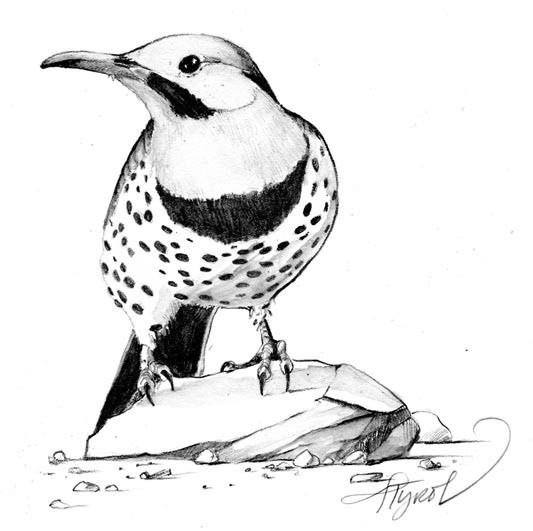
One day I looked out my kitchen window and noticed two birds I had never seen before, digging in the gravel on my driveway,
They were larger than the juncos that hunt for seeds among the driveway stones in early winter, but smaller than the mourning doves that sometimes strut along the drive in spring and summer.
These birds were a vivid tan in color and had black scalloping on their wings and black speckles on their breasts. Their sturdy bills curved slightly downward. Most striking were the bright red crescents on the backs of their heads.
Surely, I thought, they must be rare in this region.
They were northern flickers, and they are rare in once sense: They are woodpeckers, but they are the only woodpeckers found hunting for food on the ground. While other woodpeckers hammer trees to extract insects, flickers generally stay grounded and poke their bills into the dirt to search for ants and beetle larvae, their main food.
Though I hadn’t seen one before, they are quite common in North America. Northern flickers are one of the continent’s most widely distributed bird species, ranging from Alaska to Mexico, from East Coast to West. Flickers found in the West, however, are slightly different in appearance than the ones we see here, with those west of the Rockies having salmon-colored underwings and those in the East having yellow.
In most regions of the United States, northern flickers stick around for the winter, while those in Canada generally migrate south, some winding up in Southern New England. In Vermont and New Hampshire the flickers’ snow season strategy is mixed; some clearly stay put, while others likely travel to warmer environs.
Since ants are a main food, one might think that with two feet of snow covering the ground they would have to go south to survive, but they do occasionally pound on trees to get their insect dinners. They also pound on trees to carve out their nests. Like other woodpeckers, they lay their eggs in tree cavities. With trees needed for nests, and open areas needed to best find ants, it’s no surprise that flickers usually live along the edges of woods.
What surprised me is how tolerant they are of humans. The northern flicker is considered to be an urban or backyard bird, in the same league as robins, black-capped chickadees and blue jays.
The northern flicker population has been steadily declining across the country at a rate of about 2 percent per year, so in a sense my view of them was special. Over the last four decades, the population has dropped about 4 percent per year in New Hampshire and 3 percent per year in Vermont, according to the U.S. Geological Survey’s analysis of breeding birds. A 3 or 4 percent annual decrease, over 40 years, can add up to a total decline in the range of 70 percent. (The good news however, is that decline seems to have slowed in recent years.)
The reasons for the decline are a mystery, but scientists have made several educated guesses.
“One of my pet theories has been the loss of nesting habitat,” says Dr. Pamela Hunt, senior conservation biologist at New Hampshire Audubon. “People are getting rid of hedgerows between large fields,” she said referring to one of their prime habitats.
Hunt doubts that any kind of food shortage is to blame. Even in the suburbs, she says, “there are plenty of ants.”
When the flicker decline became most obvious in the 1990s, some scientists began blaming starlings, a non-native bird that competes with flickers for nesting sites. Hunt says the starling population is declining as well, so if starlings are a factor, they “are not as big a factor as they used to be.”
Another possibility is insecticide ingestion, she said. Scientists have evidence that the populations of birds that take insects on the wing—aerial foragers—have declined sharply in the last few years. Hunt believes that if flying insects with certain amounts of insecticide are responsible in some way, perhaps ground insects are also to blame.
The ants in my driveway haven’t been doused with any poison, so maybe I can hope for more glimpses of this beautiful bird. They’re always welcome to park at the dinner table next to my car.

